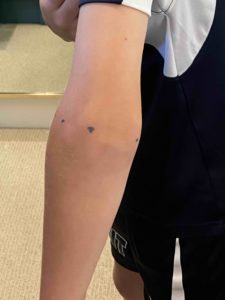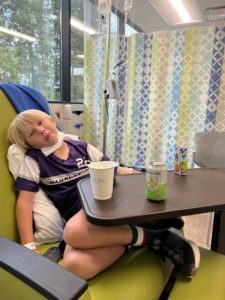Four years ago, Batten Joyner, an avid baseball player who lives in Wilson, NC, couldn’t bend his elbow because it was so swollen. Now he’s 10 years old and plays competitive baseball without any mobility issues.
It’s a proud moment for Batten’s mom, Grey Joyner, who says it took countless doctor appointments, X-rays and tests to finally get to the root of what was causing the swelling: juvenile arthritis.

“We saw several different specialists across the Triangle, and no one could tell us what was wrong,” Joyner says. “At one point, we were told it might be bone cancer and we were panicking. His pediatrician finally suggested we see a pediatric rheumatologist, and I asked for the best of the best. That’s how we ended up at UNC Health.”
UNC Health pediatric rheumatologist Eveline Wu, MD was able to restore the mobility in his elbow and get him on a treatment plan that allows him to play lots of baseball—he’s a pitcher, second baseman and utility player.
“The fact that Batten has been able to play baseball at the level he has due to the care of his doctors and parents is truly amazing,” says his coach, Jon Smith. “He never complains or makes excuses. He loves playing baseball, and I am so happy he can do that.”
We asked Dr. Wu and Laura Cannon, MD, another UNC Health pediatric rheumatologist, to explain juvenile arthritis and share some of the most common symptoms.
What Is Juvenile Arthritis?
Arthritis is best known as the joint pain and inflammation that typically occurs in older adults, but children can experience arthritis, too. In fact, juvenile arthritis is one of the more common chronic diseases of childhood, Dr. Wu says.
Juvenile arthritis is an umbrella term for several autoimmune conditions that occur when the immune system mistakenly attacks healthy cells instead of foreign ones such as viruses and germs.
Juvenile idiopathic arthritis is the most common form of juvenile arthritis (idiopathic means the cause is not known) and there are several types. It is diagnosed when joint inflammation lasts for longer than six weeks in children younger than 16 years old and other causes have been ruled out. The inflammation can cause pain and restrict mobility, as it did for Batten.
Juvenile idiopathic arthritis, which was formerly known as juvenile rheumatoid arthritis, affects 1 to 4 in 1,000 children, Dr. Cannon says. The good news is that some, but not all, types of childhood arthritis can be outgrown.
Batten’s Story
When Batten saw Dr. Wu for the first time, she found inflammation not only in his elbow but also in his hand, knee and lower back. The inflammation in his elbow had

caused the tissue in the joint to scar and stiffen, causing it to feel “stuck” and unable to move.
She diagnosed him with enthesitis-related arthritis; enthesitis is swelling in the places where tendons or ligaments attach to the bone.
Fortunately, Dr. Wu and her team were able to heal the inflammation and restore mobility in Batten’s elbow by using a medication that interferes with the body’s inflammatory response.
“We were having to give Batten a shot every few weeks, and it worked well, but he is terrified of shots,” Joyner says. “Now we take him for monthly infusions and that has been working great.”
Batten can now play baseball to his heart’s content.
“This kid loves baseball. There was a period of time where we had to take his baseball bat, helmet and even the bases everywhere we went,” Joyner says.
The goal of treatment is to reach a state of remission, where the arthritis doesn’t cause symptoms, Dr. Wu says. Sometimes kids with the type of arthritis Batten has need to continue specialty care into adulthood, even if a state of remission is reached.
However, thanks to significant medical advancements in arthritis treatment, many people with juvenile arthritis are able to live normal, healthy lives full of activities without limitation, Dr. Cannon says.
Symptoms of Juvenile Arthritis
In most cases, juvenile arthritis causes inflammation and swelling in the joints. There are two major signs of juvenile idiopathic arthritis that parents should watch for in their children, Dr. Cannon says.
The first is the loss of milestones. For example, if your child was walking but now they’re not or they start bearing weight differently while they walk.
The second is joint pain, stiffness or swelling in the morning or after a nap.
“Kids are usually quick to get up and go,” Dr. Cannon says. “But if you start to notice stiffness when they get out of bed or their joints looking big and swollen in the morning, reach out to your provider.”
Juvenile arthritis doesn’t always cause symptoms in the joints. Symptoms can include high fever, rash and eye pain. And some types of juvenile arthritis can affect internal organs such as the digestive tract (diarrhea and bloating), lungs (shortness of breath) and heart, according to the Arthritis Foundation.
Early intervention is key to preventing long-term joint or bone damage. Contact your pediatrician if you notice any symptoms. They can refer you to a rheumatologist if an autoimmune condition is suspected.
Treatment Options for Juvenile Arthritis
Treatment for juvenile arthritis, which focuses on bringing down inflammation, has come a long way in the past several decades, Dr. Cannon says.

If many joints are infected, an immunosuppressant might be used to regain control in the immune system and bring the inflammation down. A disease-modifying anti-rheumatic medicine, such as methotrexate, and corticosteroids can help ease inflammation. There is also a category of medicines called biologics that block the protein that causes inflammation in the body. Biologics can be injected or infused. Pain relievers may be used in conjunction with anti-inflammatory therapies.
“We can achieve full remission on medication,” Dr. Cannon says. “We’ll try to get the arthritis under control and then will taper off the medicines and see how the patient does. Sometimes the arthritis flares back up and they need to go back on the medicine, but sometimes they can stop taking it.”
Joyner says it was hard for her at first to learn that Batten’s condition would likely stay with him the rest of his life. But now, as Batten’s future is as bright as ever, she says raising awareness and finding support is crucial.
“I want other families to know that even though it can be difficult, a juvenile arthritis diagnosis is not the end of the world,” Joyner says. “There are so many choices for treatment. If your child is diagnosed with an autoimmune condition, it’s important to talk about it and find other parents and children going through the same thing who can support you along the way.”
Looking for a pediatric rheumatologist? Find one near you.

